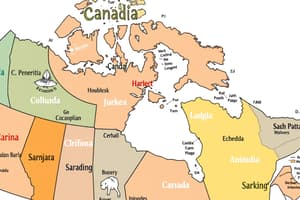Podcast
Questions and Answers
Who is part of the Executive Branch?
Who is part of the Executive Branch?
- Governor General
- Prime Minister
- Cabinet Ministers
- All of the above (correct)
What does the Governor General approve for a bill to be passed?
What does the Governor General approve for a bill to be passed?
Royal Assent
Who appoints the Prime Minister?
Who appoints the Prime Minister?
The Monarch on the recommendation of the Prime Minister
What are the steps to how laws are passed in the House of Commons?
What are the steps to how laws are passed in the House of Commons?
Cabinet Ministers are responsible for proposing laws without the involvement of the Prime Minister.
Cabinet Ministers are responsible for proposing laws without the involvement of the Prime Minister.
What is the term for the system through which Members of Parliament are elected?
What is the term for the system through which Members of Parliament are elected?
How many Senator seats are there in Canada?
How many Senator seats are there in Canada?
The __ branch of the government interprets and applies the laws.
The __ branch of the government interprets and applies the laws.
What does the Supreme Court do?
What does the Supreme Court do?
Which Prime Minister led Canada from 2006 to 2015?
Which Prime Minister led Canada from 2006 to 2015?
What is a political party?
What is a political party?
Flashcards are hidden until you start studying
Study Notes
Executive Branch
-
The Executive Branch is responsible for proposing laws, setting government policies, and managing daily government operations.
-
It consists of the Governor General, Prime Minister, and Cabinet Ministers.
Governor General
-
Represents the Monarch in Canada.
-
Approves laws, ensuring no bill is passed without their royal assent (signature).
-
Appointed by the Monarch upon the Prime Minister's recommendation.
-
Mary Simon is the current Governor General.
Prime Minister
-
Leads Canada's government.
-
Chooses Cabinet Ministers and decides which portfolios (departments) to include.
-
Collaborates with the Cabinet to propose laws.
-
Must be elected as their political party's leader and as a Member of Parliament.
-
Their party needs to win the federal election to hold office.
-
Justin Trudeau is the current Prime Minister.
Famous Prime Ministers
-
Pierre Elliott Trudeau (Liberal Party): 1968-1979, 1980-1984
-
Stephen Harper (Conservative Party): 2006-2015
-
Sir John A. Macdonald (Liberal-Conservative Party): 1867-1873, 1878-1891
-
Jean Chrétien (Liberal Party): 1993-2003
Cabinet
-
Consists of approximately 30 Cabinet Ministers.
-
Ministers collaborate with the Prime Minister to propose laws.
-
They are responsible for specific portfolios, such as defense, environment, health, and justice.
-
They must be Members of Parliament or Senators.
-
Appointed by the Prime Minister.
Legislative Branch
-
Comprises the Governor General, Senate, and House of Commons.
-
Responsible for debating bills and creating laws.
-
Represents Canadian citizens.
House of Commons
-
The lower house/chamber of Parliament.
-
Holds 338 Member of Parliament (MP) seats, which change based on population.
-
MPs represent their constituents in their riding (area).
-
Study, debate, and vote on proposed bills.
-
Inform voters about new laws and policies.
-
Elected through the First-Past-The-Post system in each riding.
-
Elected for up to five years.
Senate
-
The upper house/chamber of Parliament.
-
Consists of 105 Senators, as guaranteed by the Constitution.
-
Represents the interests and rights of Canada's regions, with a focus on minorities.
-
Provides a "sober second thought" to bills passed by the House of Commons.
-
Appointed by the Prime Minister.
-
Senators can stay in office until they are 75 years old.
Judicial Branch
-
Consists of the Supreme Court of Canada (9 judges), Federal Courts, and Provincial/Territorial Courts.
-
Interprets and applies laws.
-
Protects the rights of Canadians.
-
Supreme Court judges are nominated by the Prime Minister and Cabinet, followed by review by Members of Parliament.
Law-Making Process
-
House of Commons:
- First Reading: Bill is received, printed, and circulated for MPs to read.
- Second Reading: Bill is debated, and a vote is taken on the principle idea.
- Committee Stage: Bill is studied, experts and the public are consulted, and a report is made on whether to accept it.
- Report Stage: Amendments (changes) to the bill are debated and voted on.
- Third and Final Reading: Final debate and vote of approval.
-
Senate:
- First Reading: Bill is received, printed, and circulated for Senators to read.
- Second Reading: Bill is debated, and a vote is taken on the principle idea.
- Committee Stage: Bill is studied, experts and the public are consulted, and a report is made on whether to accept it.
- Report Stage: Amendments (changes) to the bill are debated and voted on.
- Third and Final Reading: Final debate and vote of approval.
-
**If the Senate makes significant amendments or doesn't approve the bill, it goes through steps 1-10 again.
-
Royal Assent: The Governor General signs the bill, making it a law.
Political Parties
-
Organized groups with similar political aims and goals.
-
Share similar ideas about how the government should operate.
Studying That Suits You
Use AI to generate personalized quizzes and flashcards to suit your learning preferences.




